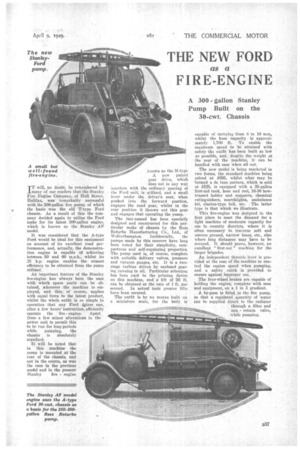as a
Page 63

If you've noticed an error in this article please click here to report it so we can fix it.
FIRE-ENGINE
TT will, no doubt, be remembered by Jimmy of our readers that the Stanley Fire Engine Company,,of Hall Street, Halifax, was remarkably successful with its 200-gallon fire pump, of which the basis was the old T-type Ford chassis. As a result of this the company decided again to utilize the Ford make for its latest 300-gallon engine, which is known as the Stanley AF model.
It was considered that the A-type Ford would be ideal for this equipment on account of its excellent road performance, and, actually, the demonstration engine is capable of achieving between 50 and 60 m.p.h., whilst its 25 h.p. engine enables the utmost efficienes to be obtained from the pump An important feature of the Stanley lire-engine has always been the ease with which spare parts can be ob taMed, wherever the machine is employed, and this, of course, applies
with equal force to the latest product, whilst the whole outfit is so simple in operation that any Ford dsriver can, after a few hours' instruction, efficiently operate the fire engine. Apart from a few minor alterations in the power unit to permit this to be run for long periods while pumping, the
chassis is absolutely • standard.
It will be noted that in this machine the pump is mounted at the rear of the chassis, and not in the centre, as was the case in the previous model and in the present
Stanley fire engine known as the M-type.
A new patent gear drive, which does not in any way interfere with the ordinary gearing of the Ford unit, is utilized, and a all lever •under the driver's. seat, When pushed into the forward . position, engages the road gear, whilst' in the rear position it throws out this gear and engages that operating the pump.
The last-named has been specially designed and constructed for this particular make of chassis by the Rees Returbo Matiufactaring Co., 1std., of Wolverhampton. Incidentally, the pumps made by this concern have long been noted for their simplicity, compactness and self-regulating properties. The pump used is, of course, complete with suitable delivery valves, pressure and vacuum gauges, etc. It is a twostage turbine driven by enclosed gearing running in oil. Particular attention has been paid to the priming device On this machine, and a lift of 26 ft. can be obtained at the rate of 1 ft. per second. In actual tests greater. lifts have been secured.
The outfit is by no menus built on a miniatare scale, for the bOdy is capable of carrying from 8 to 10 men, whilst the hose capacity is approximately 1,700 ft. To enable the maximum speed to be attained with safety the outfit has been built as lo* as possible, and, despite the weight at the rear of the machine, it can be handled with ease when all out.
The new model is being marketed in
two forms, the standard machine being priced at 695, whilst what May be termed a de luxe pattern, which is sold at i825, is equipped with a 35-gallon 'first-aid tank, hose and reel, 16-30 bowtrussed ladder and supports, chemical extinguishers, 'searchlights, ambulance kit, clarion-type bell, etc. The latter type is that which we illustrate.
This fire-engine was designed in the first place to meet the demand for a light machine of moderate capacity for use in country districts, where it is often necessary to_ traverse soft and uneven ground, narrow lanes, etc., also where long distances may have to be covered. It should prove, however, an excellent " first-out " machine for the larger brigades.
An independent throttle lever is pro vided at the rear of the machine to control the engine speed when pumping, and a safety -catch is providedto ensure against improper use. • .The" four-wheel brakes are capable of holding the engine; complete with men and equipment, on a 1 in 5 gradient.
. A by-pass is fitted to the fire pump, so that a.regahtted eluantity of water can he supplied direct. to the radiator through a filter and non.return valve, while pumping.




















































































































